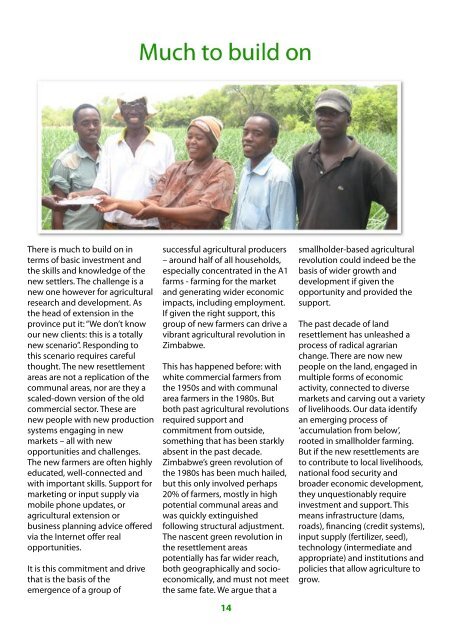Zimbabwe's Land Reform
Zimbabwe's Land Reform
Zimbabwe's Land Reform
Create successful ePaper yourself
Turn your PDF publications into a flip-book with our unique Google optimized e-Paper software.
There is much to build on in<br />
terms of basic investment and<br />
the skills and knowledge of the<br />
new settlers. The challenge is a<br />
new one however for agricultural<br />
research and development. As<br />
the head of extension in the<br />
province put it: “We don’t know<br />
our new clients: this is a totally<br />
new scenario”. Responding to<br />
this scenario requires careful<br />
thought. The new resettlement<br />
areas are not a replication of the<br />
communal areas, nor are they a<br />
scaled-down version of the old<br />
commercial sector. These are<br />
new people with new production<br />
systems engaging in new<br />
markets – all with new<br />
opportunities and challenges.<br />
The new farmers are often highly<br />
educated, well-connected and<br />
with important skills. Support for<br />
marketing or input supply via<br />
mobile phone updates, or<br />
agricultural extension or<br />
business planning advice offered<br />
via the Internet offer real<br />
opportunities.<br />
It is this commitment and drive<br />
that is the basis of the<br />
emergence of a group of<br />
successful agricultural producers<br />
– around half of all households,<br />
especially concentrated in the A1<br />
farms - farming for the market<br />
and generating wider economic<br />
impacts, including employment.<br />
If given the right support, this<br />
group of new farmers can drive a<br />
vibrant agricultural revolution in<br />
Zimbabwe.<br />
This has happened before: with<br />
white commercial farmers from<br />
the 1950s and with communal<br />
area farmers in the 1980s. But<br />
both past agricultural revolutions<br />
required support and<br />
commitment from outside,<br />
something that has been starkly<br />
absent in the past decade.<br />
Zimbabwe’s green revolution of<br />
the 1980s has been much hailed,<br />
but this only involved perhaps<br />
20% of farmers, mostly in high<br />
potential communal areas and<br />
was quickly extinguished<br />
following structural adjustment.<br />
The nascent green revolution in<br />
the resettlement areas<br />
potentially has far wider reach,<br />
both geographically and socioeconomically,<br />
and must not meet<br />
the same fate. We argue that a<br />
14<br />
smallholder-based agricultural<br />
revolution could indeed be the<br />
basis of wider growth and<br />
development if given the<br />
opportunity and provided the<br />
support.<br />
The past decade of land<br />
resettlement has unleashed a<br />
process of radical agrarian<br />
change. There are now new<br />
people on the land, engaged in<br />
multiple forms of economic<br />
activity, connected to diverse<br />
markets and carving out a variety<br />
of livelihoods. Our data identify<br />
an emerging process of<br />
‘accumulation from below’,<br />
rooted in smallholder farming.<br />
But if the new resettlements are<br />
to contribute to local livelihoods,<br />
national food security and<br />
broader economic development,<br />
they unquestionably require<br />
investment and support. This<br />
means infrastructure (dams,<br />
roads), financing (credit systems),<br />
input supply (fertilizer, seed),<br />
technology (intermediate and<br />
appropriate) and institutions and<br />
policies that allow agriculture to<br />
grow.

















